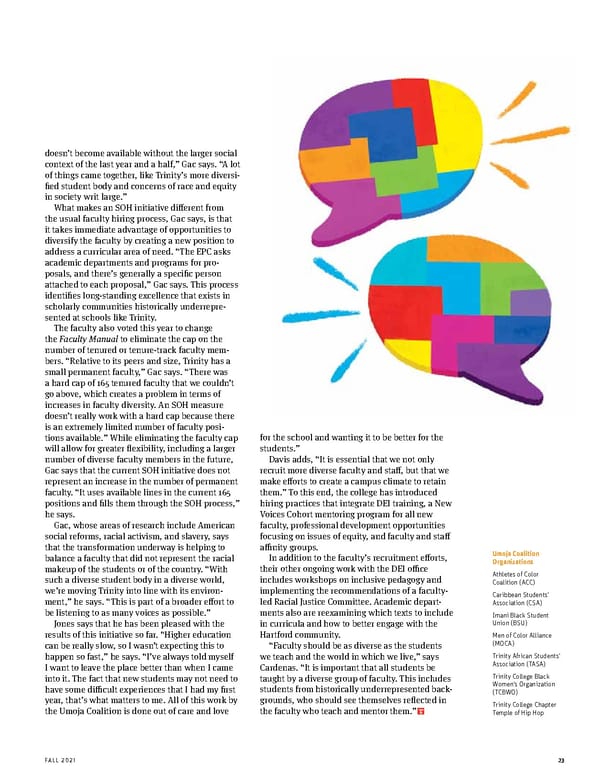doesn’t become available without the larger social context of the last year and a half,” Gac says. “A lot of things came together, like Trinity’s more diversi- ifed student body and concerns of race and equity in society writ large.” What makes an SOH initiative different from the usual faculty hiring process, Gac says, is that it takes immediate advantage of opportunities to diversify the faculty by creating a new position to address a curricular area of need. “The EPC asks academic departments and programs for pro- posals, and there’s generally a speciifc person attached to each proposal,” Gac says. This process identiifes long-standing excellence that exists in scholarly communities historically underrepre- sented at schools like Trinity. The faculty also voted this year to change the Faculty Manual to eliminate the cap on the number of tenured or tenure-track faculty mem- bers. “Relative to its peers and size, Trinity has a small permanent faculty,” Gac says. “There was a hard cap of 165 tenured faculty that we couldn’t go above, which creates a problem in terms of increases in faculty diversity. An SOH measure doesn’t really work with a hard cap because there is an extremely limited number of faculty posi- tions available.” While eliminating the faculty cap for the school and wanting it to be better for the will allow for greater lfexibility, including a larger students.” number of diverse faculty members in the future, Davis adds, “It is essential that we not only Gac says that the current SOH initiative does not recruit more diverse faculty and staff, but that we represent an increase in the number of permanent make efforts to create a campus climate to retain faculty. “It uses available lines in the current 165 them.” To this end, the college has introduced positions and iflls them through the SOH process,” hiring practices that integrate DEI training, a New he says. Voices Cohort mentoring program for all new Gac, whose areas of research include American faculty, professional development opportunities social reforms, racial activism, and slavery, says focusing on issues of equity, and faculty and staff that the transformation underway is helping to aiffnity groups. Umoja Coalition balance a faculty that did not represent the racial In addition to the faculty’s recruitment efforts, Organizations makeup of the students or of the country. “With their other ongoing work with the DEI oiffce Athletes of Color such a diverse student body in a diverse world, includes workshops on inclusive pedagogy and Coalition (ACC) we’re moving Trinity into line with its environ- implementing the recommendations of a faculty- Caribbean Students’ ment,” he says. “This is part of a broader effort to led Racial Justice Committee. Academic depart- Association (CSA) be listening to as many voices as possible.” ments also are reexamining which texts to include Imani Black Student Jones says that he has been pleased with the in curricula and how to better engage with the Union (BSU) results of this initiative so far. “Higher education Hartford community. Men of Color Alliance can be really slow, so I wasn’t expecting this to “Faculty should be as diverse as the students (MOCA) happen so fast,” he says. “I’ve always told myself we teach and the world in which we live,” says Trinity African Students’ I want to leave the place better than when I came Cardenas. “It is important that all students be Association (TASA) into it. The fact that new students may not need to taught by a diverse group of faculty. This includes Trinity College Black have some diiffcult experiences that I had my ifrst students from historically underrepresented back- Women’s Organization (TCBWO) year, that’s what matters to me. All of this work by grounds, who should see themselves relfected in Trinity College Chapter the Umoja Coalition is done out of care and love the faculty who teach and mentor them.” Temple of Hip Hop FALL 2021 23
 The Trinity Reporter, Fall 2021 Page 24 Page 26
The Trinity Reporter, Fall 2021 Page 24 Page 26